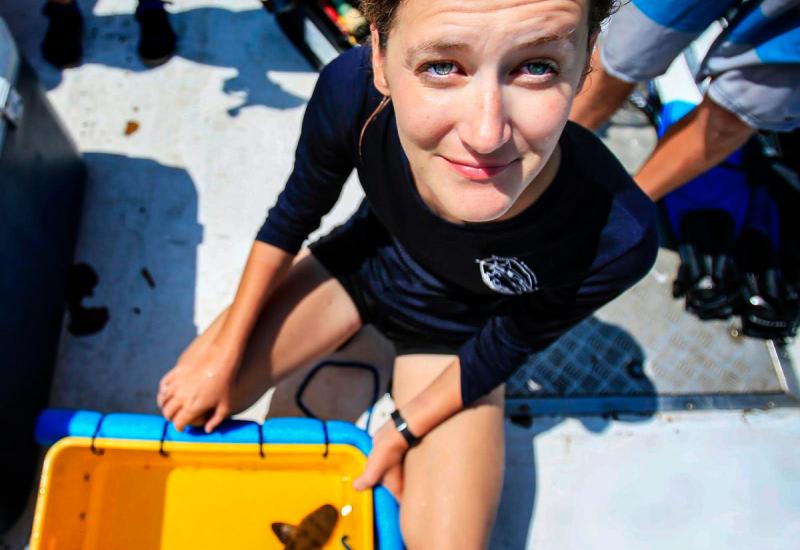Tragedy at Tanjung Luar
I never expected my first sighting of a hammerhead shark to be the lifeless body of one on a concrete slab, especially considering this species is protected by CITES. But now I was documenting the catch at one of Indonesia’s largest and most notorious fish markets, Tanjung Luar.
The Tanjung Luar market on east Lombok is on the radar of a number of shark and manta conservationists, including MantaWatch, Aquatic Alliance, Gili Eco Trust and Project AWARE. “Unfortunately, there are no regulations in place — catch quotas, minimum sizes or fishing bans — that would ensure the sustainability of wild populations and the well-being of coastal communities who depend on them,” says Andrew Harvey of MantaWatch.
For generations, the market has been a hub for local villagers selling their catch, but in recent years, the demand for shark fins and manta gills has made these catches financially lucrative. Conservationists say that enormous sums circulating the Chinese market importing these goods has spurred increased catches — and raised alarm. According to Harvey, the meat and gills from a single manta generates roughly $350. Two pounds of shark fins gets about $200.
Delphine Robbe, head of the local agency Gili Eco Trust, says the Tanjung Luar fishery also supplies manta gills that are used in traditional Chinese medicine. Dolphins and whales caught are cut up for shark bait, and their skin is used to make crackers called “krupuk.”
Those who stand to earn the greatest financial gain from Tanjung Luar also have the influence to ensure regulations are not enacted. Death threats have been reported by those working to restrict the number of sharks and mantas fished to expose the illegal practices of the fishery.
“We have heard rumors that the Indonesian government has a difficult time sending people to enforce laws at the fishery, as most fisheries personnel are actually afraid to go to Tanjung Luar,” says Peter Bassett of Aquatic Alliance, one agency working in the region. “And the scary truth is there are potentially many more shark and manta fisheries in Indonesia like Tanjung Luar that we don’t even know about.”
Education is key in establishing and enforcing regulations. “We are making a documentary to educate people because most people don’t know about [Tanjung Luar],” says Robbe. “And we are hoping to offer alternative solutions for the fishermen.”
After we went to press with this story, Indonesia announced the creation of a massive sanctuary and banned fishing for and exporting of manta rays within the country’s exclusive economic zone, including Lombok. The challenge, however, according to Conservation International, is enforcing the ban in a country made up of more than 17,000 islands where law enforcement is often weak.

Courtesy Peter Bassett/ Aquatic AllianceA man cuts off a manta ray's fins.
I never expected my first sighting of a hammerhead shark to be the lifeless body of one on a concrete slab, especially considering this species is protected by CITES. But now I was documenting the catch at one of Indonesia’s largest and most notorious fish markets, Tanjung Luar.
The Tanjung Luar market on east Lombok is on the radar of a number of shark and manta conservationists, including MantaWatch, Aquatic Alliance, Gili Eco Trust and Project AWARE. “Unfortunately, there are no regulations in place — catch quotas, minimum sizes or fishing bans — that would ensure the sustainability of wild populations and the well-being of coastal communities who depend on them,” says Andrew Harvey of MantaWatch.
For generations, the market has been a hub for local villagers selling their catch, but in recent years, the demand for shark fins and manta gills has made these catches financially lucrative. Conservationists say that enormous sums circulating the Chinese market importing these goods has spurred increased catches — and raised alarm. According to Harvey, the meat and gills from a single manta generates roughly $350. Two pounds of shark fins gets about $200.

Alex Mustard/Bluegreen PicturesAccording to Andrew Harvey of MantaWatch, the meat and gills from a single manta are sold for $350.
Delphine Robbe, head of the local agency Gili Eco Trust, says the Tanjung Luar fishery also supplies manta gills that are used in traditional Chinese medicine. Dolphins and whales caught are cut up for shark bait, and their skin is used to make crackers called “krupuk.”
Those who stand to earn the greatest financial gain from Tanjung Luar also have the influence to ensure regulations are not enacted. Death threats have been reported by those working to restrict the number of sharks and mantas fished to expose the illegal practices of the fishery.

Courtesy Peter Bassett/ Aquatic AllianceFinger-size shark pups are casualties of the illegal fishery.
“We have heard rumors that the Indonesian government has a difficult time sending people to enforce laws at the fishery, as most fisheries personnel are actually afraid to go to Tanjung Luar,” says Peter Bassett of Aquatic Alliance, one agency working in the region. “And the scary truth is there are potentially many more shark and manta fisheries in Indonesia like Tanjung Luar that we don’t even know about.”
Education is key in establishing and enforcing regulations. “We are making a documentary to educate people because most people don’t know about [Tanjung Luar],” says Robbe. “And we are hoping to offer alternative solutions for the fishermen.”

Courtesy Peter Bassett/ Aquatic AllianceA worker cleans an already-finned shark.
After we went to press with this story, Indonesia announced the creation of a massive sanctuary and banned fishing for and exporting of manta rays within the country’s exclusive economic zone, including Lombok. The challenge, however, according to Conservation International, is enforcing the ban in a country made up of more than 17,000 islands where law enforcement is often weak.










